Sustainable Development Goal 3
Ensure healthy lives and promote well-being for all at all ages
Sustainable Development Goal 3 is to “ensure healthy lives and promote well-being for all at all ages”, according to the United Nations.
The visualizations and data below present the global perspective on where the world stands today and how it has changed over time.
The UN has defined 13 targets and 28 indicators for SDG 3. Targets specify the goals and indicators represent the metrics by which the world aims to track whether these targets are achieved. Below we quote the original text of all targets and show the data on the agreed indicators.
List of targets and indicators
Target 3.1Reduce maternal mortality
SDG Indicator 3.1.1Maternal mortality ratio
Definition of the SDG indicator: Indicator 3.1.1 is the “maternal mortality ratio” in the UN SDG framework.
The maternal mortality ratio refers to the number of women who die from pregnancy-related causes while pregnant or within 42 days of pregnancy termination per 100,000 live births.
Data for this indicator is shown in the interactive visualization.
Target: By 2030 “reduce the global maternal mortality ratio to less than 70 per 100,000 live births” per year.
More research: The Our World in Data topic page on Maternal Mortality gives a long-run perspective over the last centuries and presents research on the causes and consequences of the deaths of mothers.
Additional charts

SDG Indicator 3.1.2Skilled birth attendance
Definition of the SDG indicator: Indicator 3.1.2 is the “proportion of births attended by skilled health personnel” in the UN SDG framework.
This indicator is measured as the ratio of the births attended by skilled health personnel (generally doctors, nurses, or midwives) who are trained in providing quality obstetric care, to the number of live births in the same period.
Data for this indicator is shown in the interactive visualization.
Target: By 2030 “reduce the global maternal mortality ratio to less than 70 per 100,000 live births” per year.
More research: Research, discussed in the Our World in Data topic page on Maternal Mortality, shows that skilled staff can reduce maternal mortality.

Target 3.2End all preventable deaths under 5 years of age
SDG Indicator 3.2.1Under-5 mortality rate
Definition: Indicator 3.2.1 is the “under-5 mortality rate” in the UN SDG framework.
The under-5 mortality rate measures the probability per 1,000 that a newborn baby will die before reaching age five, if subject to age-specific mortality rates of the specified year.
Data for this indicator is shown in the interactive visualization.
Target: By 2030, “end preventable deaths of newborns and children under 5 years of age, with all countries aiming to reduce neonatal mortality to at least as low as 12 per 1,000 live births and under-5 mortality to at least as low as 25 per 1,000 live births.”
More research: Child mortality is covered more broadly, and with a longer-term perspective in the Our World in Data topic page on Child Mortality.

SDG Indicator 3.2.2Neonatal mortality rate
Definition of the SDG indicator: Indicator 3.2.2 is the “neonatal mortality rate” in the UN SDG framework.
The neonatal mortality rate is defined as the probability per 1,000 that a child born in a given year will die during the first 28 days of life, if subject to the age-specific mortality rates of that period.
Data on this indicator is shown in the interactive visualization.
Target: By 2030, “end preventable deaths of newborns and children under 5 years of age, with all countries aiming to reduce neonatal mortality to at least as low as 12 per 1,000 live births and under-5 mortality to at least as low as 25 per 1,000 live births.”
More research: The Our World in Data topic page on Child Mortality includes a section on neonatal mortality.
Additional charts

Target 3.3Fight communicable diseases
SDG Indicator 3.3.1HIV incidence
Definition of the SDG indicator: Indicator 3.3.1 is the “number of new HIV infections per 1,000 uninfected population, by sex, age and key populations” in the UN SDG framework.
Data for this indicator is shown in the interactive visualization, by age group in the first chart and for the 15-49 age group in the second chart. You can change the country shown in the first chart by clicking the “Change country” button in the upper left hand corner.
Target: The target for 2030 is to “end the epidemic of AIDS” across all countries.1
The targeted level of reduction is defined by UNAIDS as a 90% reduction in new HIV infections over 2010 levels. For all age groups combined, this would imply a target of around .03 per 1,000, or 3 new infections for every 100,000 uninfected people.
More research: HIV is covered in detail by the Our World in Data topic page on HIV/AIDS.
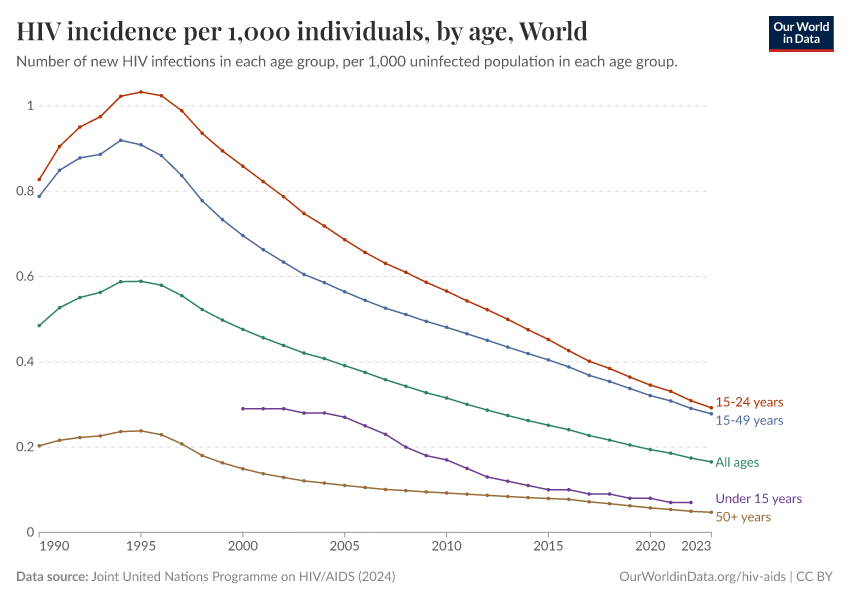
SDG Indicator 3.3.2Tuberculosis incidence
Definition of the SDG indicator: Indicator 3.3.2 is “tuberculosis incidence per 100,000 population” in the UN SDG framework.
Tuberculosis incidence is the number of new and relapse cases of tuberculosis (TB) per 100,000 people, including all forms of TB.
Data for this indicator is shown in the interactive visualization.
Target: The 2030 target is to “end the epidemic of tuberculosis” in all countries.1
The World Health Organization's End TB Strategy defines this targeted level of reduction as a decrease in incidence of 80% over 2015 levels. This would imply a target of around 28 cases per 100,000 population globally.
Additional charts

SDG Indicator 3.3.3Malaria incidence
Definition of the SDG indicator: Indicator 3.3.3 is “malaria incidence per 1,000 population” in the UN SDG framework.
Malaria incidence is the number of new cases of malaria in one year per 1,000 people at risk.
Data on this indicator is shown in the interactive visualization.
Target: By 2030 “end the epidemic of malaria” in all countries.1
To achieve this target, the WHO Global Technical Strategy has set a target of reducing incidence by 90% by 2030 from 2015 levels. This would imply a target of 6 or fewer cases of malaria per 1,000 people globally in 2030.
More research: More information on global and national trends in malaria prevalence, deaths and interventions can be found at the Our World in Data topic page on Malaria.
Additional charts

SDG Indicator 3.3.4Hepatitis B incidence
Definition of the SDG indicator: Indicator 3.3.4 is “Hepatitis B incidence per 100,000 population” in the UN SDG framework.
Hepatitis B incidence is the number of new cases of hepatitis B in one year per 100,000 people in a given population. This is measured indirectly as the share of children under 5 years of age with an active Hepatitis B infection, as measured by an Hepatitis B surface antigen test.
Data for this indicator is shown in the interactive visualization.
Target: By 2030 “combat hepatitis” in all countries with a focus on hepatitis B.1 The targeted level of reduction, however, is not defined.
Additional charts

SDG Indicator 3.3.5Neglected tropical diseases
Definition of the SDG indicator: Indicator 3.3.5 is the “number of people requiring interventions against neglected tropical diseases” in the UN SDG framework.
This is defined as the number of people who require interventions (treatment and care) for any of the 20 neglected tropical diseases (NTDs) identified by the WHO NTD Roadmap and World Health Assembly resolutions. Treatment and care is broadly defined to allow for preventive, curative, surgical or rehabilitative treatment and care.
Data for this indicator is shown in the interactive visualization.
Target: By 2030 “end the epidemic of neglected tropical diseases (NTDs)” in all countries.1
The associated WHO target is a 90% reduction in the number of people requiring interventions against NTDs from 2010 baseline levels. This implies a target of 219 million people needing interventions against NTDs in 2030.
Additional charts

Target 3.4Reduce mortality from non-communicable diseases and promote mental health
SDG Indicator 3.4.1Mortality rate from non-communicable diseases
Definition of the SDG indicator: Indicator 3.4.1 is the “mortality rate attributed to cardiovascular disease, cancer, diabetes or chronic respiratory disease” in the UN SDG framework.
This is defined as the percent of 30-year-old-people who would die before their 70th birthday from cardiovascular disease, cancer, diabetes, or chronic respiratory disease, assuming that they would experience current mortality rates at every age and would not die from any other cause of death (e.g. injuries or HIV/AIDS).
Data for this indicator is shown in the interactive visualization.
Target: By 2030 “reduce by one third premature mortality from non-communicable diseases through prevention and treatment” in all countries.2
More research: Further data and research on non-communicable diseases can be found at the Our World in Data topic pages on Causes of Death, Burden of Disease, and Cancer.
Additional charts

SDG Indicator 3.4.2Suicide rate
Definition of the SDG indicator: Indicator 3.4.2 is the “suicide mortality rate” in the UN SDG framework.
The suicide mortality rate is the number of deaths from suicide measured per 100,000 people in a given population.
Data for this indicator is shown in the interactive visualization.
Target: By 2030 “promote mental health and wellbeing”.2 There is no defined target level of reduction for this indicator.
More research: Further data and research on suicide, mental health and wellbeing can be found at the Our World in Data topic pages on Suicide, Mental Health and Happiness and Life Satisfaction.
Additional charts

Target 3.5Prevent and treat substance abuse
SDG Indicator 3.5.1Coverage of treatment interventions for substance use disorders
Definition of the SDG indicator: Indicator 3.5.1 is the “coverage of treatment interventions (pharmacological, psychosocial and rehabilitation and aftercare services) for substance use disorders” in the UN SDG framework.
This is the share of people with substance use disorders in a given year who receive treatment in the form of pharmacological, psychosocial, rehabilitation or aftercare services. Data coverage in household surveys of substance use disorders is limited in many countries, and efforts are currently in progress to better estimate this indicator.
Data for this indicator is shown in the interactive visualizations. The first chart shows the share of the population with an alcohol use disorder in each country, and the second chart shows coverage of treatment interventions for certain types of substance use disorder for the countries where this data is available.
Target: By 2030 “strengthen the prevention and treatment of substance abuse, including narcotic drug abuse and harmful use of alcohol” across all countries. However, there is no defined target level for this indicator.
More research: The Our World in Data topic page on Substance Use provides data on substance use disorder prevalence and as well as more limited data coverage of treatment interventions.

SDG Indicator 3.5.2Alcohol consumption per capita
Definition of the SDG indicator: Indicator 3.5.2 is the “harmful use of alcohol, defined according to the national context as alcohol per capita consumption (aged 15 years and older) within a calendar year in litres of pure alcohol” in the UN SDG framework.
Data for this indicator is shown in the interactive visualization.
Target: By 2030 “strengthen the prevention and treatment of substance abuse, including narcotic drug abuse and harmful use of alcohol” across all countries. However, there is no defined target level for this indicator.
More research: Further data and research on alcohol consumption and alcohol use disorders can be found at the Our World in Data topic page on Alcohol Consumption.

Target 3.6Reduce road injuries and deaths
SDG Indicator 3.6.1Halve the number of road traffic deaths
Definition of the SDG indicator: Indicator 3.6.1 is the “death rate due to road traffic injuries” in the UN SDG framework.
Road traffic deaths include vehicle drivers, passengers, motorcyclists, cyclists and pedestrians.
Data for this indicator is shown in the first chart in the series of interactive visualizations. The second chart shows the absolute number of road traffic deaths for additional context.
Target: By 2020 “halve the number of global deaths and injuries from road traffic accidents.”
While most SDG targets are set for 2030, this was set to be achieved for 2020.
Note that the SDG Indicator is the rate of road deaths while the target is set for the absolute number of road deaths. Because of this, the interactive visualization shows, in the first chart, the road traffic death rate, and in the second chart, the number of road traffic deaths.
Additional charts
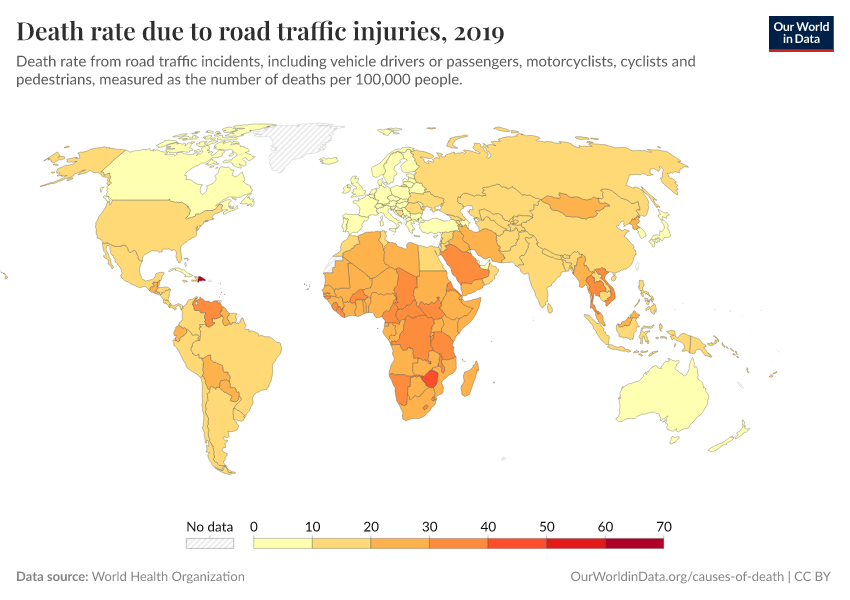
Target 3.7Universal access to sexual and reproductive care, family planning and education
SDG Indicator 3.7.1Family planning needs
Definition of the SDG indicator: Indicator 3.7.1 is the “proportion of women of reproductive age (aged 15–49 years) who have their need for family planning satisfied with modern methods” in the UN SDG framework.
This indicator incorporates two components, the prevalence of modern methods of contraception, and the share of women of reproductive age who want to stop or delay childbearing but are not using any method of contraception.
It is measured as the percent of women of reproductive age (15-49 years) who are currently using at least one modern contraceptive method, out of the total population of women who have demand for contraceptive methods (defined as those using contraception of any form or who have unmet need for contraception).
Data for this indicator is shown in the interactive visualization.
Target: By 2030 “ensure universal access to sexual and reproductive healthcare services, including for family planning, information and education.”3
More research: Further data and research can be found at the Our World in Data topic page on Fertility Rate.
Additional charts
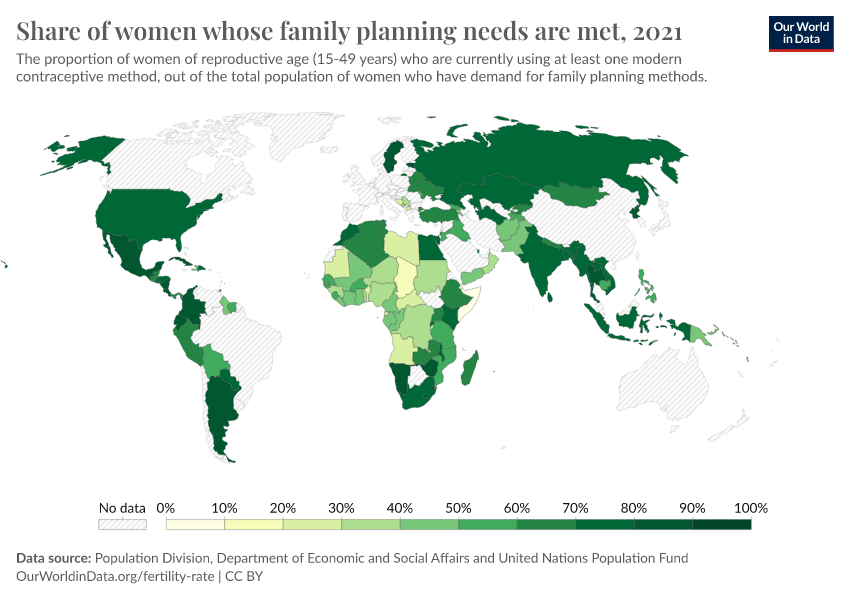
SDG Indicator 3.7.2Adolescent birth rate
Definition of the SDG indicator: Indicator 3.7.2 is the “adolescent birth rate (aged 10–14 years; aged 15–19 years) per 1,000 women in that age group” in the UN SDG framework.
Data for this indicator is shown in the interactive visualizations, which show, in the first chart, adolescent birth rates per 1,000 women aged 10-14 years old, and in the second chart, women aged 15-19 years old.
Target: By 2030 “ensure universal access to sexual and reproductive healthcare services, including for family planning.”3
More research: Further data and research can be found at the Our World in Data topic page on Fertility Rate.
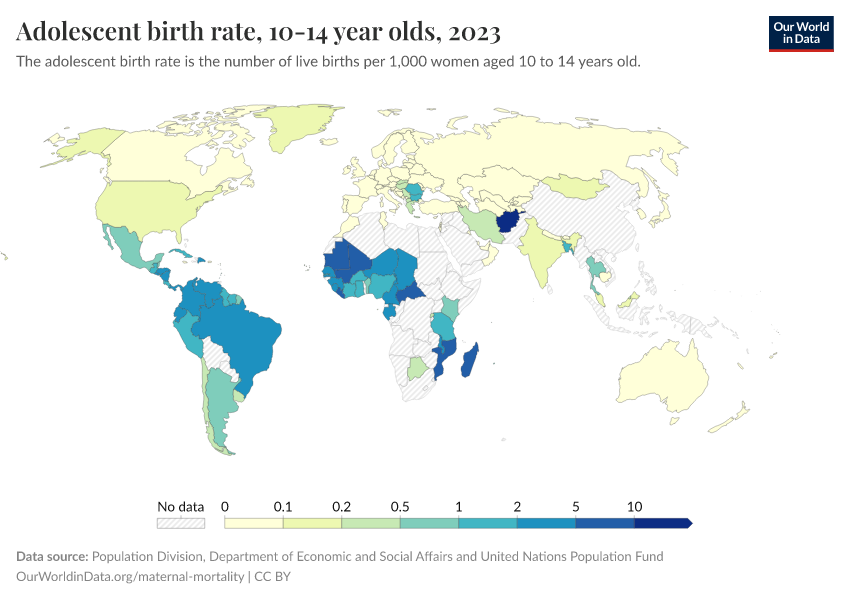
Target 3.8Achieve universal health coverage
SDG Indicator 3.8.1Coverage of essential health services
Definition of the SDG indicator: Indicator 3.8.1 is “coverage of essential health services” in the UN SDG framework.
Coverage of essential health services is defined as the average coverage of essential services based on tracer interventions that include reproductive, maternal, newborn and child health, infectious diseases, non-communicable diseases and service capacity and access, among the general and the most disadvantaged population.
The Universal Health Coverage (UHC) Service Coverage Index is used to track progress on this indicator. The index is on a scale from 0 to 100, where 100 is the optimal value, and calculated from the geometric mean of 14 indicators measuring the coverage of essential services including reproductive, maternal, newborn and child health, infectious diseases, non-communicable diseases and service capacity and access.
Data for this indicator is shown in the interactive visualization.
Target: By 2030 “achieve universal health coverage including financial risk protection, access to quality essential health-care services and access to safe, effective, quality and affordable essential medicines and vaccines for all.”
More research: Further data and research can be found at the Our World in Data topic page on Financing Healthcare.
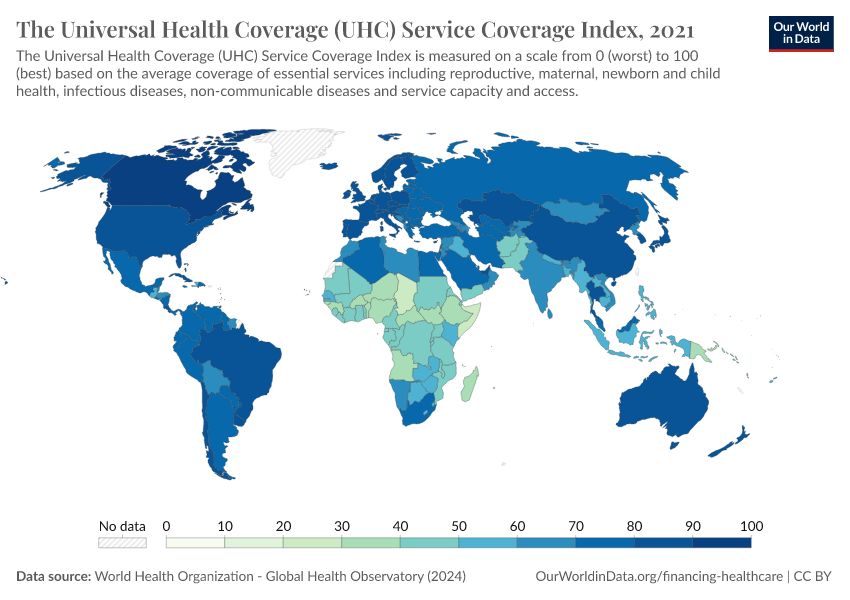
SDG Indicator 3.8.2Household expenditures on health
Definition of the SDG indicator: Indicator 3.8.2 is the “proportion of population with large household expenditures on health as a share of total household expenditure or income” in the UN SDG framework.
Two thresholds are used for defining large household expenditures: greater than 10% or 25% of total household expenditure or income.
The interactive visualizations show data for the 25 and 10 percent thresholds.
Target: By 2030 “achieve universal health coverage, including financial risk protection, access to quality essential health-care services and access to safe, effective, quality and affordable essential medicines and vaccines for all.”
More research: Further data and research can be found at the Our World in Data topic page on Financing Healthcare.

Target 3.9Reduce illnesses and deaths from hazardous chemicals and pollution
SDG Indicator 3.9.1Mortality rate from air pollution
Definition of the SDG indicator: Indicator 3.9.1 is the “mortality rate attributed to household and ambient air pollution” in the UN SDG framework.
This is measured as the number of deaths attributed to indoor and outdoor air pollution per 100,000 people, accounting for differences in the age structure of different populations.
Data for this indicator is shown in the series of interactive visualizations, first for household and ambient air pollution combined, then for each separately, and then with a comparison of the two types of pollution in the final chart.
Target: By 2030 “substantially reduce the number of deaths and illnesses from hazardous chemicals and air, water and soil pollution and contamination.” There is, however, not a defined target level for this indicator.
More research: Further data and research can be found at the Our World in Data topic pages on Air Pollution and Indoor Air Pollution.

SDG Indicator 3.9.2Mortality rate from unsafe water, sanitation, hygiene (WASH)
Definition of the SDG indicator: Indicator 3.9.2 is the “mortality rate attributed to unsafe water, unsafe sanitation and lack of hygiene” in the UN SDG framework.
This indicator is defined as the number of deaths per 100,000 people that are attributed to unsafe water, unsafe sanitation, and lack of hygiene (defined as exposure to unsafe Water, Sanitation, and Hygiene for All (WASH) services). This definition includes deaths from diarrhoea, intestinal nematode infections, malnutrition and acute respiratory infections.
Data for this indicator is shown in the interactive visualization.
Target: By 2030 “substantially reduce the number of deaths and illnesses from hazardous chemicals and air, water and soil pollution and contamination.” There is, however, not a defined quantified target level for this indicator.
More research: Further data and research can be found at the Our World in Data topic page on Water Access, Resources and Sanitation.

SDG Indicator 3.9.3Mortality rate from unintentional poisoning
Definition of the SDG indicator: Indicator 3.9.3 is the “mortality rate attributed to unintentional poisoning” in the UN SDG framework.
This measures the annual number of deaths per 100,000 people that are attributed to unintentional poisonings.
Data for this indicator is shown in the interactive visualization.
Target: By 2030 “substantially reduce the number of deaths and illnesses from hazardous chemicals and air, water and soil pollution and contamination.” There is, however, not a defined quantified target level for this indicator.

Target 3.aImplement the WHO framework convention on tobacco control
SDG Indicator 3.a.1Prevalence of tobacco use
Definition of the SDG indicator: Indicator 3.a.1 is the “age-standardized prevalence of current tobacco use among persons aged 15 years and older” in the UN SDG framework.
This measures the share of people aged 15 and older who currently use any tobacco product, whether smoked or smokeless tobacco. This includes both people who use tobacco on a daily basis as well as those who use it on a non-daily basis but have used it at some point in the last 30 days before the survey. Age-standardization accounts for differences in age distributions between countries.
Data for this indicator is shown in the interactive visualization.
Target: By 2030 “strengthen the implementation of the World Health Organization Framework Convention on Tobacco Control in all countries, as appropriate.” There is no specified target level of tobacco use for this indicator.
More research: Further data and research can be found at the Our World in Data topic page on Smoking.

Target 3.bSupport research, development and access to affordable vaccines and medicines
SDG Indicator 3.b.1Vaccine coverage
Definition of the SDG indicator: Indicator 3.b.1 is the “proportion of the target population covered by all vaccines included in their national programme” in the UN SDG framework.
The UN currently includes the four following vaccines in this indicator: three-dose diphtheria, pertussis, and tetanus (DPT3); second-dose measles vaccine; recommended dose of pneumococcal conjugate vaccine (PCV3) and recommended dose of human papillomavirus vaccine.
Data on this indicator is shown across the four interactive visualizations.
Target: By 2030 “provide access to affordable essential medicines and vaccines.”4
For this indicator, this means universal coverage of the vaccines noted above (if included in national vaccination programmes) must be achieved by 2030.

SDG Indicator 3.b.2Development assistance to medical research & basic healthcare
Definition: Indicator 3.b.2 is the “total net official development assistance (ODA) to medical research and basic health sectors” in the UN SDG framework.
This indicator is measured as disbursements of official development assistance (ODA) and other official flows to the medical research and basic health sectors.
Official development assistance refers to flows to countries and territories on the Organization for Economic Co-operation and Development’s Development Assistance Committee (DAC) and to multilateral institutions which meet a set of criteria related to the source of the funding, the purpose of the transaction, and the concessional nature of the funding.
Data for this indicator is shown for recipient countries.
Target: By 2030 “support the research and development of vaccines and medicines for the communicable and non-communicable diseases that primarily affect developing countries, [and] provide access to affordable essential medicines and vaccines.”4
More research: Further data and research can be found at the Our World in Data topic page on Financing Healthcare.

SDG Indicator 3.b.3Availability of essential medicines
Definition: Indicator 3.b.3 is the “proportion of health facilities that have a core set of relevant essential medicines available and affordable on a sustainable basis” in the UN SDG framework.
This indicator measures the share of surveyed healthcare facilities that had essential medicines available for purchase at prices, such that no extra daily wages would be needed for the lowest paid unskilled government sector worker to purchase a monthly dose treatment of this medicine after fulfilling their basic needs represented by the national poverty line.
The list of 32 essential medicines used in calculation is from the 2017 Model List of Essential Medicines from the WHO Expert Committee on Selection and Use of Essential Medicines, which updates its list of essential medicines every two years. Availability and affordability of specific medicines are weighted in the overall calculation based on the regional burden of disease.
Data for this indicator is shown in the interactive visualization.
Target: By 2030 “provide access to affordable essential medicines for all.”4

Target 3.cIncrease health financing and support health workforce in developing countries
SDG Indicator 3.c.1Health worker density
Definition: Indicator 3.c.1 is “health worker density and distribution” in the UN SDG framework.
Health worker density is the size of the health workforce per 1,000 people. It is measured here based on the density of physicians, surgeons, nurses and midwives, dentistry and pharmaceutical personnel.
Target: By 2030 “substantially increase health financing and the recruitment, development, training and retention of the health workforce in developing countries.”

Target 3.dImprove early warning systems for global health risks
SDG Indicator 3.d.1Health emergency preparedness
Definition: Indicator 3.d.1 is the “International Health Regulations (IHR) capacity and health emergency preparedness” in the UN SDG framework.
The IHR Core capacity index is measured in terms of 15 capacities, where each capacity is measured as the average implementation score across a set of indicators. Countries self-report progress in the following 15 capacities: (1) Policy, legal and normative instruments to implement IHR; (2) IHR Coordination and National Focal Point Functions; (3) Financing; (4) Laboratory; (5) Surveillance; (6) Human resources; (7) Health emergency management (8) Health Service Provision; (9) Infection Prevention and Control; (10) Risk communication and community engagement; (11) Points of entry and border health; (12) Zoonotic diseases; (13) Food safety; (14) Chemical events; (15) Radiation emergencies.
Data for this indicator is shown in the interactive visualization.
Target: By 2030 “strengthen the capacity of all countries, in particular developing countries, for early warning, risk reduction and management of national and global health risks.”

SDG Indicator 3.d.2Bloodstream infections due to antimicrobial-resistant organisms
Definition of the SDG indicator: Indicator 3.d.2 is the “percentage of bloodstream infections due to selected antimicrobial-resistant organisms” in the UN SDG framework.
This is measured as the share of people who are found to have a bloodstream infection due to certain antimicrobial-resistant organisms (methicillin-resistant Staphylococcus aureus (MRSA) and Escherichia coli resistant to 3rd-generation cephalosporin), among those seeking care whose blood sample is collected and tested.
Data for this indicator is shown in the interactive visualizations.
Target: By 2030 “strengthen the capacity of all countries, in particular developing countries, for early warning, risk reduction and management of national and global health risks.”

Endnotes
Full text: “By 2030, end the epidemics of AIDS, tuberculosis, malaria and neglected tropical diseases and combat hepatitis, water-borne diseases and other communicable diseases.”
Full text: “By 2030, reduce by one third premature mortality from non-communicable diseases through prevention and treatment and promote mental health and well-being.”
Full text:” By 2030, ensure universal access to sexual and reproductive health-care services, including for family planning, information and education, and the integration of reproductive health into national strategies and programmes.”
Full text: “Support the research and development of vaccines and medicines for the communicable and non-communicable diseases that primarily affect developing countries, provide access to affordable essential medicines and vaccines, in accordance with the Doha Declaration on the TRIPS Agreement and Public Health, which affirms the right of developing countries to use to the full the provisions in the Agreement on Trade-Related Aspects of Intellectual Property Rights regarding flexibilities to protect public health, and, in particular, provide access to medicines for all.”
Cite this work
Our articles and data visualizations rely on work from many different people and organizations. When citing this article, please also cite the underlying data sources. This article can be cited as:
Our World in Data team (2023) - “Ensure healthy lives and promote well-being for all at all ages” Published online at OurWorldinData.org. Retrieved from: 'https://archive.ourworldindata.org/20260105-133053/sdgs/good-health-wellbeing.html' [Online Resource] (archived on January 5, 2026).BibTeX citation
@article{owid-sdgs-good-health-wellbeing,
author = {Our World in Data team},
title = {Ensure healthy lives and promote well-being for all at all ages},
journal = {Our World in Data},
year = {2023},
note = {https://archive.ourworldindata.org/20260105-133053/sdgs/good-health-wellbeing.html}
}Reuse this work freely
All visualizations, data, and code produced by Our World in Data are completely open access under the Creative Commons BY license. You have the permission to use, distribute, and reproduce these in any medium, provided the source and authors are credited.
The data produced by third parties and made available by Our World in Data is subject to the license terms from the original third-party authors. We will always indicate the original source of the data in our documentation, so you should always check the license of any such third-party data before use and redistribution.
All of our charts can be embedded in any site.